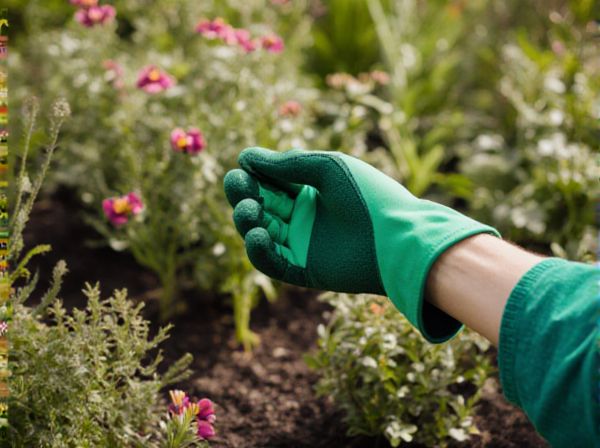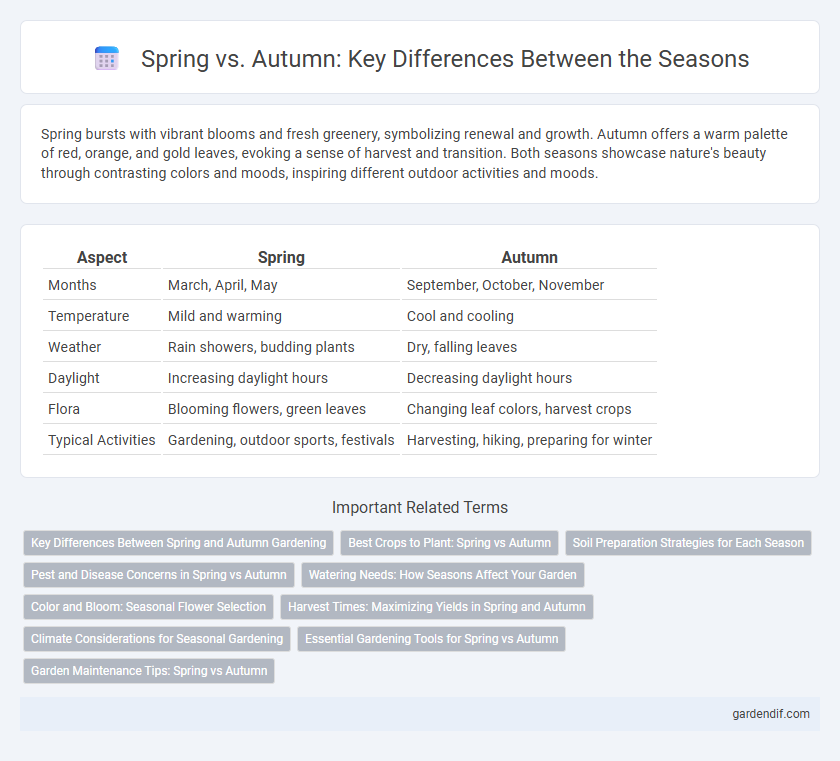
Spring vs Autumn Illustration
Spring bursts with vibrant blooms and fresh greenery, symbolizing renewal and growth. Autumn offers a warm palette of red, orange, and gold leaves, evoking a sense of harvest and transition. Both seasons showcase nature's beauty through contrasting colors and moods, inspiring different outdoor activities and moods.
Table of Comparison
| Aspect | Spring | Autumn |
|---|---|---|
| Months | March, April, May | September, October, November |
| Temperature | Mild and warming | Cool and cooling |
| Weather | Rain showers, budding plants | Dry, falling leaves |
| Daylight | Increasing daylight hours | Decreasing daylight hours |
| Flora | Blooming flowers, green leaves | Changing leaf colors, harvest crops |
| Typical Activities | Gardening, outdoor sports, festivals | Harvesting, hiking, preparing for winter |
Key Differences Between Spring and Autumn Gardening
Spring gardening emphasizes planting early blossoms, nurturing seedlings, and preparing soil for warm-weather crops, while autumn gardening centers on harvesting summer produce, planting cool-season vegetables, and mulching to protect plants from frost. Temperature variations influence plant choices: spring favors heat-tolerant varieties like tomatoes and peppers, whereas autumn supports hardy greens such as kale and spinach. Soil moisture levels also differ, with spring requiring irrigation to support germination, and autumn relying more on natural rainfall for plant hydration.
Best Crops to Plant: Spring vs Autumn
Spring offers an ideal environment for planting crops like tomatoes, lettuce, and peas due to warmer soil temperatures and increased sunlight, promoting faster germination and growth. In contrast, autumn favors cool-season crops such as kale, carrots, and broccoli, which thrive in cooler temperatures and shorter days, enhancing their flavor and hardiness. Choosing the best crops for each season optimizes yield and ensures a continuous harvest throughout the year.
Soil Preparation Strategies for Each Season
Spring soil preparation emphasizes warming and loosening the soil to enhance nutrient availability and root growth, often involving light tilling and the addition of compost or organic matter. Autumn soil preparation focuses on enriching soil fertility through the application of cover crops, green manure, and mulching to protect and improve soil structure during dormant months. Tailoring soil amendments and moisture management to seasonal conditions maximizes crop yield and soil health in both spring and autumn.
Pest and Disease Concerns in Spring vs Autumn
In spring, increased humidity and rising temperatures create ideal conditions for fungal diseases like powdery mildew and rust, while pest activity such as aphids and caterpillars surges due to new plant growth. Autumn sees a decline in pest populations but higher risks of root rot and leaf spot diseases because of cooler, wetter weather. Effective seasonal pest management in spring emphasizes early detection and preventive spraying, whereas autumn requires rigorous sanitation practices to reduce overwintering disease inoculum.
Watering Needs: How Seasons Affect Your Garden
Spring typically demands more frequent watering due to increased plant growth and warmer temperatures causing faster soil evaporation. In contrast, autumn requires reduced watering as cooler weather slows plant metabolism and natural rainfall often supplements moisture. Understanding these seasonal watering variations helps optimize garden health and conserve water resources.
Color and Bloom: Seasonal Flower Selection
Spring showcases vibrant blooms like tulips, daffodils, and cherry blossoms, painting landscapes with pastel pinks, yellows, and whites. Autumn features rich, warm hues from chrysanthemums, marigolds, and asters, reflecting deep oranges, reds, and golds. Seasonal flower selection highlights the stark contrast in color palettes, with spring favoring soft and fresh tones while autumn embraces earthy and intense shades.
Harvest Times: Maximizing Yields in Spring and Autumn
Spring harvest times center around early-ripening crops like peas, asparagus, and strawberries, enabling multiple growth cycles and maximizing yields through successive planting. Autumn harvest favors late-season fruits and vegetables such as pumpkins, apples, and root vegetables, benefiting from cooler temperatures that enhance flavor and storage longevity. Optimizing harvest schedules in both seasons requires aligning crop selection with climate patterns and soil conditions to ensure peak productivity and quality.
Climate Considerations for Seasonal Gardening
Spring offers warmer temperatures and increased rainfall, creating ideal conditions for planting most vegetables and flowers while minimizing frost risk. Autumn presents cooler temperatures and reduced daylight, requiring gardeners to select hardy plants and use protective measures against early frosts. Understanding these climate variations helps optimize planting schedules and improve garden health during seasonal transitions.
Essential Gardening Tools for Spring vs Autumn
Essential gardening tools for spring include pruning shears for trimming new growth, garden forks for aerating soil, and seed trays for starting seedlings, enabling optimal plant development. Autumn requires robust rakes for clearing fallen leaves, spades for turning compost, and gloves designed for wet conditions to prepare gardens for the colder months. Choosing season-specific tools enhances garden maintenance efficiency and supports healthy plant cycles during both spring and autumn.
Garden Maintenance Tips: Spring vs Autumn
Spring garden maintenance emphasizes soil preparation, planting fresh blooms, and regular watering to support rapid growth during warmer days. Autumn garden care focuses on clearing fallen leaves, pruning perennials, and mulching to protect roots from colder temperatures. Effective seasonal maintenance enhances plant health, promotes vibrant growth, and prepares the garden for winter dormancy or spring revival.
Spring vs Autumn Infographic

 gardendif.com
gardendif.com